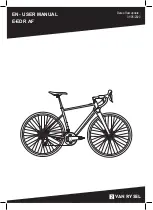
E. Pedals
1
. Toe Overlap is when your toe can touch the front wheel when you turn the handlebars to steer while a pedal is in the forwardmost position. This is common on
small-framed bicycles and racing bikes which have smaller wheelbases and is avoided by keeping the inside pedal up and the outside pedal down when making
sharp turns. This technique will also prevent the inside pedal from striking the ground in a turn.
!
WARNING
: Toe Overlap could cause you to lose control and fall. Ask your dealer to help you determine if the combination of frame size, crank
arm length, pedal design and shoes you will use results in pedal overlap. If you have overlap, you must keep the inside pedal down and the outside
pedal up when making sharp turns.
2
. Some bicycles come equipped with pedals that have sharp and potentially dangerous surfaces. These surfaces are designed to add safety by increasing grip
between the rider’s shoe and the pedal. If your bicycle has this type of high-performance pedal, you must take extra care to avoid serious injury from the pedals’
sharp surfaces. Based on your riding style or skill level, you may prefer a less aggressive pedal design, or chose to ride with shin pads. Your dealer can show
you a number of options and make suitable recommendations.
3
. Toeclips and straps are a means to keep feet correctly positioned and engaged with the pedals. The toeclip positions the ball of the foot over the pedal
spindle, which gives maximum pedaling power. The toe strap, when tightened, keeps the foot engaged throughout the rotation cycle of the pedal. While toeclips
and straps give some benefit with any kind of shoe, they work most effectively with cycling shoes designed for use with toeclips. Your dealer can explain how
toeclips and straps work. Shoes with deep treaded soles or welts which might allow the foot to be trapped should not be used with toeclips and straps.
!
WARNING
: Getting into and out of pedals with toeclips and straps requires skill which can only be acquired with practice. Until it becomes a re-
flex action, the technique requires concentration which can distract your attention and cause you to lose control and fall. Practice the use of toeclips
and straps where there are no obstacles, hazards or traffic. Keep the straps loose, and don’t tighten them until your technique and confidence in
getting in and out of the pedals warrants it. Never ride in traffic with your toe straps tight.
4
. Clipless pedals (sometimes called “step-in pedals”) are another means to keep feet securely in the correct position for maximum pedaling efficiency. They
have a plate, called a “cleat,” on the sole of the shoe, which clicks into a mating spring-loaded fixture on the pedal. They only engage or disengage with a very
specific motion which must be practiced until it becomes instinctive. Clipless pedals require shoes and cleats which are compatible with the make and model
pedal being used.
Many clipless pedals are designed to allow the rider to adjust the amount of force needed to engage or disengage the foot. Follow the pedal manufacturer’s
30
















































